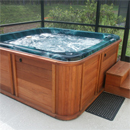

 The heat and buoyancy of hot tubs have been known to help people with uncomfortable aches and pains. Some who suffer from arthritis, fibromyalgia, and diabetes brag about the hot tubs therapeutic abilities, yet there is also evidence to indicate sitting in a hot tub can damage your health.
The heat and buoyancy of hot tubs have been known to help people with uncomfortable aches and pains. Some who suffer from arthritis, fibromyalgia, and diabetes brag about the hot tubs therapeutic abilities, yet there is also evidence to indicate sitting in a hot tub can damage your health.
According to the Mayo Clinic when the air sacs in the lungs become irritated and inflammation sets in, it is called pneumonitis. This inflammation created by pneumonitis can hamper the delivery of oxygen to your bloodstream. Studies indicate that pneumonitis is associated with specific varieties of mold and bacteria, which can lead to an infection in the lungs known as mycobacterium avium. As more cases develop physicians are referring to it as “hot tub lung”.
Why Certain Preventative Measures Need to be Taken
Here’s how hot tub lung happens: a hot tub is filled with water that is brought to a high temperature, the water becomes contaminated and bubbles form in the contaminated water from the force of the hot tub jets. These bubbles burst when they rise to the surface dispensing the bacteria into the air. You then breathe in the air, bacteria included.
Part of the problem is that a lot of hot tub owners do not change the water or filters in their hot tubs as often as is recommended. Researchers have discovered that the bacteria can multiply quickly if the chlorine levels drop and pH rises. The good news is that so far studies seem to show that the bacteria infestation is happening with indoor hot tubs, not units that are outdoors.
The symptoms of “hot tub lung” can be similar to the common cold or in some cases more severe. Chest tightness and shortness of breath is always concerning and can be associated with infections from the tubs. Preventative steps can be taken so that you don’t have to get rid of your hot tub. Following a healthy tip or two will go a long way in keeping your tub bacteria free.
• Maintain proper amounts of chlorine
• Drain and scrub tub with bleach solution at least once a month
• Keep surfaces and decks around the hot tub clean
• Always shower or bathe before using the hot tub
Taking preventative measures ahead of time seem like a small nuisance compared to the discomfort of a lung infection. A lung infection; if left undiagnosed, can lead to serious organ damage. Another healthy tip for indoor hot tub users…if you have what seems to be stubborn cold-like symptoms, fever and chills, talk to your doctor about getting a chest x-ray or CT scan. Both of these tests can detect pneumonitis. The sooner you get attention, the more chance you have of avoiding any permanent damage.
Hot tub lung does not form overnight. It is normally detected in frequent hot tub users. However, there are other types of hot tub bacteria that can cause health issues, including rashes. Again, the best preventative measure is careful control of chlorine and acid levels in the hot tub.
Damage to Your Body
Recent studies have linked too much chlorine in indoor swimming pools to lung problems. Researchers from France and Canada discovered that indoor swimmers had airway damage and scar tissue in their lungs. There is a concern that with warnings about “hot tub lung”, the pendulum will swing the other way; that people will start putting too much chlorine in their hot tubs in an attempt to avoid lung infections. While we may all have our own ideas when it comes to preventative maintenance, following hot tub guidelines when it comes to cleaning is the safest approach.
If you already suffer from heart disease, high blood pressure or diabetes, a final healthy tip would be to consult with your doctor before entering a hot tub. You could be avoiding further damage to your body
Copyright © www.orthopaedics.win Bone Health All Rights Reserved